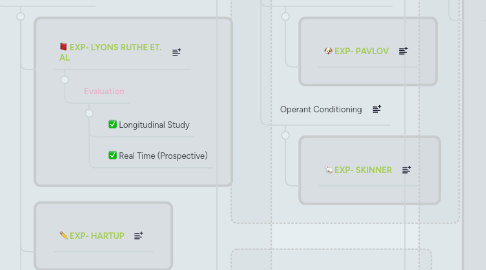
1. Disruption of Attachment
1.1. Continuity Hypothesis
1.1.1. In Children
1.1.1.1. EXP- LYONS RUTHE ET. AL
1.1.1.1.1. Evaluation
1.1.1.2. EXP- HARTUP
1.1.1.3. EXP- STRAFE and FLEESON
1.1.2. In Adolescents
1.1.2.1. EXP- MOORE
1.1.2.1.1. Evaluation
1.1.2.2. EXP- FEEENEY and NOLLER
1.1.2.2.1. Evaluation
1.1.3. Supporting
1.1.3.1. EXP- HAZAN and SHAVER
1.1.3.1.1. Evaluation
1.1.4. Against
1.1.4.1. EXP- ZIMMERMAN
1.1.4.1.1. Evaluation
1.1.4.2. EXP- WATERS ET AL.
1.1.5. EXP- RUTTER ET AL.
1.2. Deprivation
1.2.1. Maternal Deprivation Hypothesis
1.2.2. EXP- BOWLBYS 44 THIEVES
1.2.2.1. Evaluation
1.2.2.1.1. Natural Experiment
1.2.2.1.2. Retrospective Data
1.2.2.1.3. Population Validity
1.2.3. EXP- DEMO and ACOCK
1.2.3.1. Evaluation
1.2.3.1.1. Age Range
1.3. Privation
1.3.1. Case Studies
1.3.1.1. KOLUCHOVA TWINS
1.3.1.1.1. Evaluation
1.3.1.2. GENIE
1.3.2. Insitutionalisation
1.3.2.1. EXP- TIZARD and HODGES
1.3.2.1.1. Evaluation
1.3.2.2. EXP- RUTTER
2. Explanations for Attachment
2.1. Learning Theory
2.1.1. Classical Conditioning
2.1.1.1. EXP- PAVLOV
2.1.2. Operant Conditioning
2.1.2.1. EXP- SKINNER
2.2. Evolutionary Theory
2.2.1. EXP- LORENZ
2.2.2. Critical Period
2.2.3. EXP- HARLOW
2.3. Interactional Synchrony
2.3.1. EXP- CONDON and OGSTON
3. Types of Attachment
3.1. Stages of Attachment
3.1.1. EXP- SCHAFFER and EMERSON
3.1.1.1. STAGE 1: Asocial Attachment
3.1.1.2. STAGE 2: Indiscriminate Attachment
3.1.1.3. STAGE 3: Specific Attachment
3.1.1.4. STAGE 4: Multiple Attachments
3.1.1.5. Evaluation of the Study
3.1.1.5.1. Ecological Validity
3.1.1.5.2. Longitudinal Study
3.1.1.5.3. Population Validity
3.1.1.5.4. Bias
3.1.1.6. The Role of the Father
3.2. Individual Differences
3.2.1. EXP- THE STRANGE SITUATION
3.2.1.1. Procedure
3.2.1.2. The Types of Attachment
3.2.1.2.1. Secure Attachment
3.2.1.2.2. Insecure Avoidant
3.2.1.2.3. Insecure Resistant
3.2.1.3. Results
3.2.1.4. Evaluation of the Study
3.2.1.4.1. Demand Characteristics- Child
3.2.1.4.2. Ecological Validity
3.2.1.4.3. The Attachment Figures
3.2.1.4.4. Temperament
3.2.1.4.5. Demand Characteristics- Mother
3.2.1.4.6. Sample Size
3.2.1.4.7. Type D Attachment
3.2.1.5. Cross Cultural Variation
3.2.1.5.1. EXP- VAN IJZENDOORN and KRRONENBERG

